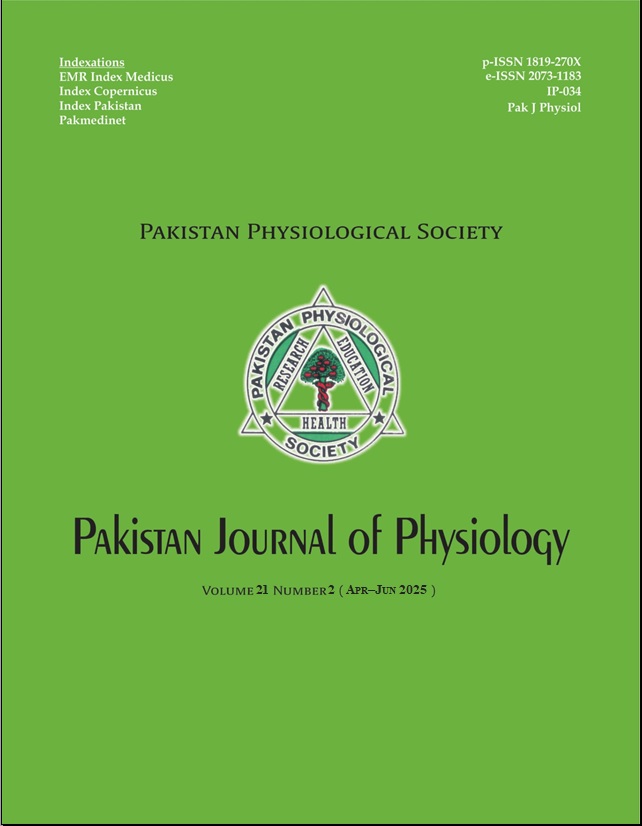A NOVEL DEPSIDE SEKIKAIC ACID IS PROTECTIVE AGAINST CYCLOPHOSPHAMIDE INDUCED CARDIOTOXICITY IN RATS
DOI:
https://doi.org/10.69656/pjp.v21i2.1776Keywords:
Cardiotoxicity, Cyclophosphamide, CP, Oxidative stress, Sekikaic acid, SAAbstract
Background: Cyclophosphamide is a widely prescribed chemotherapeutic agent. Its toxic metabolites induce oxidative stress which burdens the cardiac tissue. With recent advancements in gaining deeper insight in natural antioxidants, Sekikaic acid (SA) is gaining popularity as a novel depside compound with significant organ protective potential. This study seeks to explore and assess the cardio-protective and antioxidant effects of sekikaic acid against anti-cancer drug toxicity. Methods: Experimental animals were divided into three groups: normal untreated control, cyclophosphamide toxic control, and cyclophosphamide with sekikaic acid group where sekikaic acid was administered for 14 continuous days followed by a single dose of cyclophosphamide. For assessing myocardial injury serum cardiac biomarkers (creatine kinase, lactate dehydrogenase, troponin I, C-reactive proteins) and tissue oxidative stress markers (glutathione, super-oxide dismutases and malondialdehyde) were evaluated. Results: The control group demonstrated normal physiologic values of serum and tissue biomarkers. The toxic control demonstrated signs of cardiac injury with a single dose of cyclophosphamide, with raised levels of serum and tissue oxidative stress markers alongside receding natural antioxidant pools of glutathione and super-oxide dismutases. On the contrary the oxidative burden on myocardium was significantly reduced (p?0.05), and cellular antioxidants were preserved with co-administration of sekikaic acid validating its potential as a cardioprotective agent. Conclusion: The antioxidant potential of sekikaic acid can effectively ameliorate cyclophosphamide induced cardiotoxicity and can be incorporated in cyclophosphamide containing chemotherapeutic and immunosuppressive regimens.
Pak J Physiol 2025;21(2):38-41, DOI: https://doi.org/10.69656/pjp.v21i2.1776
Downloads
References
Abd El Salam ASG, Samaha MM, Abd Elrazik NA. Cytoprotective effects of cinnamaldehyde and adipoRon against cyclophosphamide-induced cardio-renal toxicity in rats: insights into oxidative stress, inflammation, and apoptosis. Int Immunopharmacol 2023;124:111044.
Avagimyan A, Kakturskiy L, Pogosova N, Ottaviani G, Rizzo M, Sarrafzadegan N. Doxorubicin and cyclophosphamide mode of chemotherapy-related cardiomyopathy: review of preclinical model. Curr Probl Cardiol 2025;50(1):102882.
Tripathi AH, Negi N, Gahtori R, Kumari A, Joshi P, Tewari LM, et al. A review of anti-cancer and related properties of lichen-extracts and metabolites. Anticancer Agents Med Chem 2022;22(1):115–42.
Kumar TK, Siva B, Anand A, Anusha K, Mohabe S, Reddy AM, et al. Comprehensive lichenometabolomic exploration of Ramalina conduplicans Vain using UPLC-Q-ToF-MS/MS: identification of free radical scavenging and anti-hyperglycemic constituents. Molecules 2022;27(19):6720.
Ureña-Vacas I, González-Burgos E, Divakar PK, Gómez-Serranillos MP. Lichen depsides and tridepsides: progress in pharmacological approaches. J Fungi 2023;9(1):116.
Srirangan P, Sabina EP. Protective effects of herbal compounds against cyclophosphamide-induced organ toxicity: a pathway-centered approach. Drug Chem Toxicol 2025:1–43.
Forbes P, van der Wat L, Strumpher J. Comparative perspectives on extraction methods for organic metabolites and pollutants from lichens. In: Yusuf M, (Ed). Lichen?Derived Products. 1st ed. Wiley; 2020:27–73.
Marasini BP, Yue JM, Manandhar E, Rai R, Khadka U, Manandhar MD, Shyaula SL. Tyrosinase inhibition activities of depsides isolated from Ramalina species. J Biol Act Prod Nat 2023;13(3):256–64.
Ye B, Ling W, Wang Y, Jaisi A, Olatunji OJ. Protective effects of chrysin against cyclophosphamide-induced cardiotoxicity in rats: a biochemical and histopathological approach. Chem Biodivers 2022;19(3):e202100886.
Iqubal A, Wasim M, Ashraf M, Najmi AK, Syed MA, Ali J, et al. Natural bioactive as a potential therapeutic approach for the management of cyclophosphamide-induced cardiotoxicity. Curr Top Med Chem 2021;21(29):2647–70.
Pimenta GF, Awata WMC, Orlandin GG, Silva-Neto JA, Assis VO, da Costa RM, et al. Melatonin prevents overproduction of reactive oxygen species and vascular dysfunction induced by cyclophosphamide. Life Sci 2024;338:122361.
Tatipamula VB, Annam SSP, Nguyen HT, Polimati H, Yejella RP. Sekikaic acid modulates pancreatic ?-cells in streptozotocin-induced type 2 diabetic rats by inhibiting digestive enzymes. Nat Prod Res 2021;35(23):5420–4.
Torres-Benítez A, Ortega-Valencia JE, Jara-Pinuer N, Ley-Martínez JS, Velarde SH, Pereira I, et al. Antioxidant and antidiabetic potential of the Antarctic lichen Gondwania regalis ethanolic extract: metabolomic profile and in vitro and in silico evaluation. Antioxidants 2025;14(3):298.
Muthu S, Murugan M, Rajendran K, Ponnusamy P. An assessment of proximate composition, antioxidant activities and LC/MS based phytochemical profiling of some lichen species collected from Western Ghats of Southern Part of India. Jordan J Biol Sci 2021;14(4):647–61.
Karagöz Y, Öztürk Karagöz B. Lichens in pharmacological action: what happened in the last decade? Eurasian J Med 2022;54 (Suppl 1):195–208.
Torres-Benítez A, Ortega-Valencia JE, Sanchez M, Divakar PK, Simirgiotis MJ, Gómez-Serranillos MP. Metabolomic profiling, antioxidant and enzyme inhibition properties and molecular docking analysis of Antarctic lichens. Molecules 2022;27(22):8086.
Downloads
Published
How to Cite
Issue
Section
License
Copyright (c) 2025 Maryam Saqib, Zari Salahuddin, Farah Khan Sharwani, Muhammad Usman Ali Khan

This work is licensed under a Creative Commons Attribution-NoDerivatives 4.0 International License.
The author(s) retain the copyrights and allow their publication in Pakistan Journal of Physiology, Pak J Physiol, PJP to be FREE for research and academic purposes. It can be downloaded and stored, printed, presented, projected, cited and quoted with full reference of, and acknowledgement to the author(s) and the PJP. The contents are published with an international CC-BY-ND-4.0 License.











